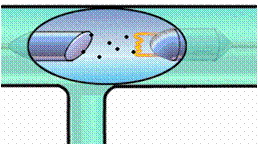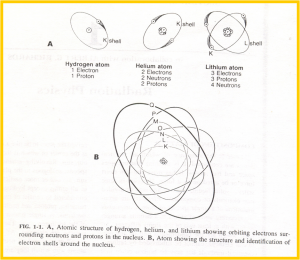Introduction
Generation, emission & absorption of radiation occurs at the subatomic level.
Nucleus- two particles- protons & neutrons [nucleons].
Particles that orbit the nucleus are the electrons.
Interest to diagnostic radiology- electrons, protons & neutrons.
number of protons- nucleus of atom- atomic number [Z].
total number of protons & neutrons – nucleus of an atom- mass number [A].
Ionization
Process of converting atoms to ions.
Addition of an electron to an electrically neutral atom –negative ion.
Heating / interactions [collisions] with high – energy X – rays / particles such as the protons can remove electrons from an atom.
This requires sufficient energy to overcome the electrostatic forces binding the electrons to the nucleus.
X- rays,Ò¯ rays & high energy particles remove these electrons.
Excitation
The raising of an electron to a higher level
No electron is lost by an atom, but one is raised into an unstable orbit & ultimately returns to its normal state with the emission of radiation characteristic of the atoms concerned.
Emission of visible / ultraviolet radiation photons.
Nature of radiation
Transmission of energy through space & matter.
2 types-particulate & electromagnetic
Particulate radiation
Atomic & subatomic particles moving at high velocity.
α,β & cathode rays
α-decay of radioactive elements
cathode rays- high speed electrons- x ray tube
β- radioactive nuclei
The capacity of particulate radiation to ionize atoms depends on its kinetic energy & its charge.
LET- linear energy transfer- rate of loss of energy from a particle as it moves along its track through matter[ tissue].
Electromagnetic radiation
Movement of energy through space as a combination of electric & magnetic fields
Velocity of an electrically charged particle is altered.
Ò¯, X-rays, UV rays, visible light, infra red radiation, television, radar, microwaves & radiowaves.
Properties of electromagnetic radiation
All travel with the same velocity in free space.
All travel in a straight line in free space.
All transfer energy from place to place, in quanta.
In passing through matter the intensity of radiation is reduced [attenuation], both because some are deflected from its original path to travel in a new direction [scattering]
In free space all electromagnetic radiations obey the inverse square law, i.e, for a point source, the radiation intensity [I] at any place varies inversely as the square of the distance [d] from the source to the place at which the intensity is considered:
I∞1/d2
X- RAYS
Interaction of electrons & atoms.
Ionizing & non- ionizing radiation.
Wave theory & quantum theory
Wave theory
Radiation propagated in the form of waves.
Waves- electrical & magnetic energy
Electric & magnetic fields are in planes at right angles to one another & are oscillating perpendicular to the direction of motion
All electromagnetic waves travel at 3 × 108 m/sec in vacuum.
Electromagnetic radiation- λ×ν=c=3×108m/sec –λ-wavelength, ν- frequency, c- velocity of light
Quantum theory
Transfer of energy by electromagnetic radiation occurs not as waves but as a flux of quanta or photons.
The unit of photon energy is electron volt [eV]
Wavelength & photon energy E=hc/λ
E= energy in KeV, h- planck’s constant[6.25 × 1034 joule-secs]
E= 1.24/λ
The quantum theory has been more successful
Correlating experimental data on the interaction of radiation with atoms,
The photoelectric effect ,
Production of line spectra &
X-rays.
DISCOVERY OF X-rays
Sir William Conrad Rontgen, 1895
Experiment- long glass vessel from which as much as possible air had been removed
into each end a platinum electrode was sealed
An electric discharge at high voltage –passed through the evacuated tube
Glow on a piece of glass, covered with zinc sulphide- short distance from the tube
Glow remained even if the tube was covered with black paper
Conclusion- undiscovered radiation-X-rays
THE X- RAY MACHINE
PARTS
X- ray tube, its power supply
Tube head
Support arm
Control panel
X- RAY TUBE HEAD
CATHODE
FOCUSING CUP
FILAMENT [source of electrons]
Tube head, components of power supply & oil that conducts heat away from the x- ray tube
ANODE
COPPER STEM
TARGET [beam of electrons is directed]
The cathode & target lie within an evacuated glass envelope or tube.
Electrons from the filament strike the target & produce X- rays.
For the X- ray tube to function an electrical power supply is necessary to establish high potentials across the tube & accelerate the electrons to very high speeds.
CATHODE-
FILAMENT-coil of tungsten wire about 0.2cm in diameter & 1cm / less in length.
It is mounted on 2 stiff wires that support it & carry the electric current.
3.These 2 mounting wires lead through the glass envelope to serve as connection to both the high & low voltage electrical sources
4.Filament is heated to incandescence across the filament from a step down transformer.
5.the hot filament emits electrons that are separated from the outer orbits of the tungsten atoms at the rate proportional to the temp of the filament – thermionic emission
6.milliampere [mA] control –fine adjustment of quantity of electrons- tube current

Filament lies in FOCUSING CUP
Negatively charged concave reflector of Mo.
Electrostatically focuses the electrons emitted by the heated filament
Narrow beam directed at a small rectangular area on the anode- focal spot
